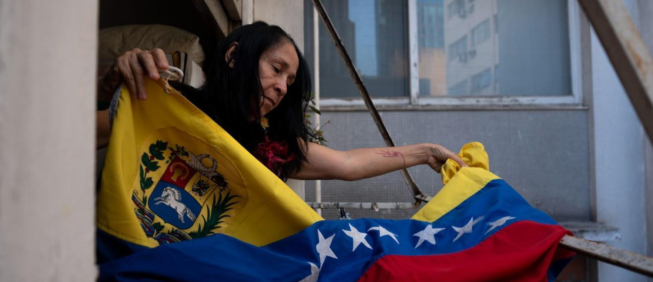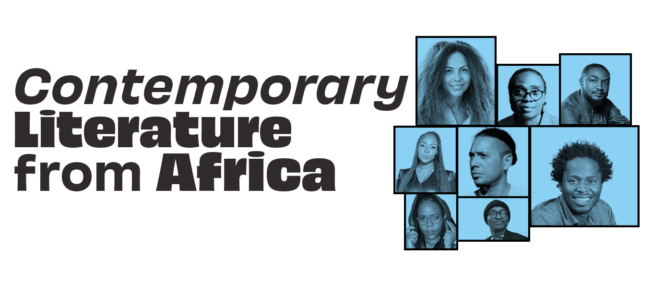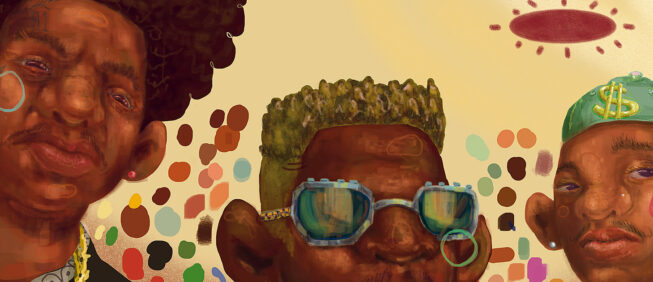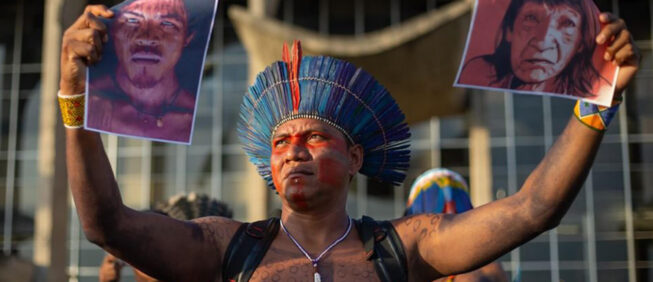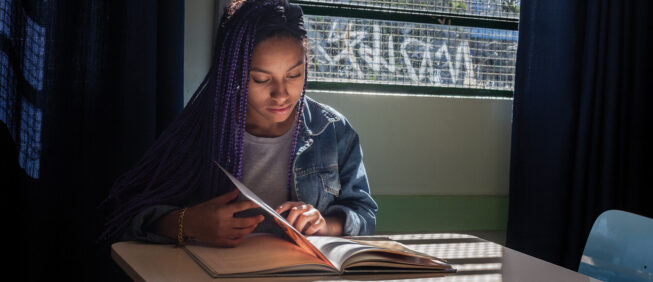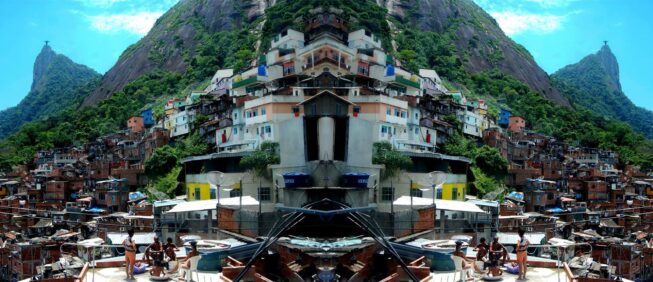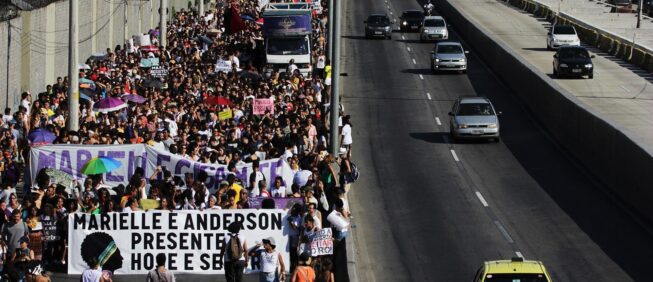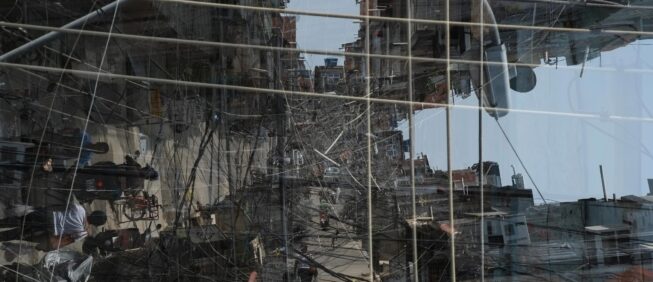Motherhood in prison
Experiences of previously incarcerated mothers in Valparaíso, Chile and how to work with reparative actions through the arts
Vania Gallardo López | Eva Lineros Vega
| Chile |
September, 2022
translated by Nicole Froio
This article emerges from community action performed by the collective Pájarx entre Púas, which is made up of women and people of dissident genders who are currently incarcerated, were previously incarcerated, activists and artists. Inspired by feminist art-ivism and action based investigations, we united to question the structures of (in)justice and punishment in this society, and to build new kinds of relationships, using the arts alongside our individual and collective corporalities as tools for transformation of the multiple forms of exclusion and violence we inhabit because of our genders, class and ethnicities. In this way, we work to transform pain into movement and movement into freedom.
We are interested in highlighting the voices of incarcerated and ex-incarcerated comrades in our territory, emphasizing their experiences of motherhood in prison. It is known that talking about prison in this globalized and capitalist society means lifting veils of historical invisibility, structures that continue to reproduce today and allow the violation of the human rights of people who are deprived of their liberty.
We live in the era of the precarization of life, a systemic crisis that violates human dignity and that has a profound impact on the bodies of women deprived of liberty, since, even though they represent only 7% of the entire prison population at the planet, during the last two decades their incarceration rate has increased by 53% (Walmsley, 2018); they are being punished for surviving poverty through being, for the most part, convicted of non-violent drug-related crimes (40.8% ), robberies (22.4%) and thefts (10.7%) (GENCHI, 2019).
We position ourselves from an activist and transfeminist perspective to address the problem of motherhood in prison, through the story of our colleagues - mothers and people with experiences of deprivation of liberty within the Women's Penitentiary Center (CPF) of Valparaíso between 2015 and 2020. In this way, they build an active use of their individual and collective memory to share their experiences, showing that incarceration generates a break in the mother-child bond and, consequently, a fragmentation of thousands of families, communities and an entire social fabric.
Therefore, the development of reparative actions through the arts for work for the reconstruction of affective and community bonds inside and outside prison is investigated here. It is a working model that the Pájarx Entre Púas collective has developed within the Valparaíso region to respond to the problem of prison and the exclusion of women, dissidence, maternity and childhood in the context of confinement.
The testimonies and works presented in this article correspond to interviews, conversations, collage creations and sound interventions, carried out inside and outside the female prisons by the collective, and they correspond to spaces for dialogue and creation that have been developed together with accompanying processes focused on personal and community reparations. In this way, the informed consent of each of the voices in this story is made transparent and we position ourselves against any form of academic extractivism.
The artworks that accompany this article are: a collage made by the artists María Paz Córdova Lagos and Marión Silva, a project of the Pájarx entre Púas Foundation and Collective based on the work "Líneas de Vuelo" ("Flight Lines"); an intervention carried out at B.A.S.E Tsonami in March 2021, in Valparaíso, Chile, with the sound artists Jasmina Al-Qaisi and Jimena Royo Letelier that reveals the reality of women deprived of liberty in the Valparaíso women's penitentiary in Chile.
To participate in this experience, we invite readers to scan the following QR Code that accompanies the graphics shown in the article.


Motherhood in prison: from the inside and out
The return to prison
According to recent data, 95% of imprisoned women in Chile are mothers of at least one child (Larroulet, et al., 2021). Additionally, they are heads of single-parent households, which is directly related to the reasons that lead them to commit crimes, since they are often the only economic and emotional support for their families. This means that many of them are forced to separate from their children when they enter prison, while others enter prison while pregnant, and therefore must serve their sentences with their children until they reach the age of two, when they are abruptly separated and are not offered appropriate support.
This is what Patricia tells us, someone who has lived through imprisonment as a mother, and later, the separation of a nursing daughter and along with it the breaking of her connections: “almost always the mothers who commit crimes do it for the children, that is how I did it, because the father is not there, because he doesn't save anyone” (Paty, 54 years old, Valparaíso).
Many women go through different stages of their motherhood during their incarceration, however, for the purposes of this article, both processes are characterized separately; firstly, motherhood in prison and, secondly, the experience of mothering at a distance due to the forced separation as a result of the mother's incarceration. In this way, it will be possible to understand the different processes that constitute the experiences of women-mothers deprived of liberty.

“When someone is incarcerated, they suffer a lot, to be deprived of liberty in between four walls, not seeing the sun, losing yourself from the sea, from the rain, that’s already a punishment”.(Paty, 54 años, Valparaíso).
Motherhood in prison begins with the vital process of pregnancy, which is affected by the structural conditions of prison, which, as Restrepo and Francés (2016) indicate, are built under a patriarchal logic of contempt for life. In women's prisons there is no guaranteed access to basic hygiene and health services, and access to sexual and obstetric health is even worse for women in the process of pregnancy, childbirth and the puerperium, as Marisol tells us: “Giving birth in prison is an experience of incarceration where children are born deprived of liberty.” (45 years old, Viña del Mar).
During the breastfeeding phase, both mothers’ and children’s fundamental rights are violated, due to mistreatment by police, healthcare personnel and court institutions. Regarding this violation [of fundamental rights] that extends to the children who live in prison, the comrades report that: "they are just like us, they are one of us, although they are apart and have their own little house, they still listen and see everything" ( Jessica, 47 years old, Viña del Mar).
The space incarcerated mothers inhabit with their children is “only cement, bars and barbed wire” (Jessica, 47 years old, Viña del Mar). In addition, it is important to consider that women exercise their maternity 24 hours a day, they do not rest from their care work, which adds to their precarious living and recreational conditions — both for them and for their children — which end up deteriorating their physical and mental health.
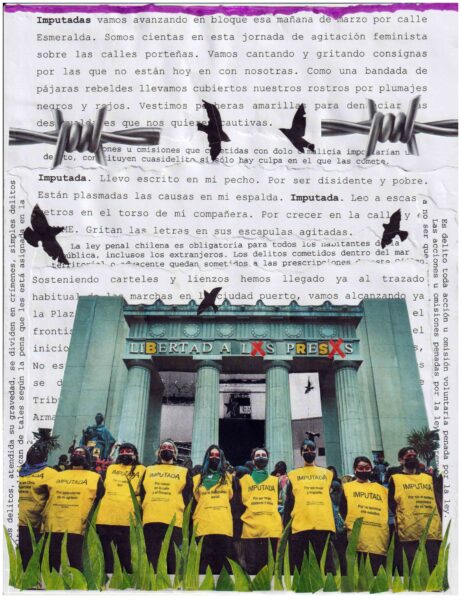
On this last point, the prison system does not comply with the mandatory protocols, even though the Human Rights Manual for Penitentiary Guards establishes that
“In what refers to “women with children within penitentiary units”, the best interests of the child must prevail (…) when they meet their mothers, they will never be treated as inmates and, the physical place where they are located, they will be separated from the rest of the prison population” (GENCHI, 2012:32).
The reality shows that out of the 40 prisons that house women, only 26 have mother-child sections, according to data from the latest national study of prison conditions (INDH, 2019). In addition to the above, ex-incarcerated women report that medical care inside the prison is of poor quality and insufficient, making up for its shortcomings through overmedicalization: “When I asked for an hour with the midwife, I did not see anyone, they only have are healthcare workers who give pills to people who feel bad (...) Once, they injected me, I don't know what they gave me and they sent me to the unit” (Jessica, 47 years old, Valparaíso).
In this way, we can note that the experience of motherhood and childhood in prison infringes on the right that both mothers and children have to be able to develop a secure affective bond with each other, and inhabiting a space as hostile as prison is a constant violation of their human rights, causing many mothers to separate from their children before the time established by law (two years of age), which profoundly affects their identity and affective processes due to the guilt and stigmatization that deprivation of liberty entails, since it must be remembered that the criminal justice system: "tries to perpetuate the hegemonic and heterocentric models of 'good woman' and 'good mother'" (Gea Fernández, 2014, p. 217 et seq.; Francés and Restrepo, 2011) .
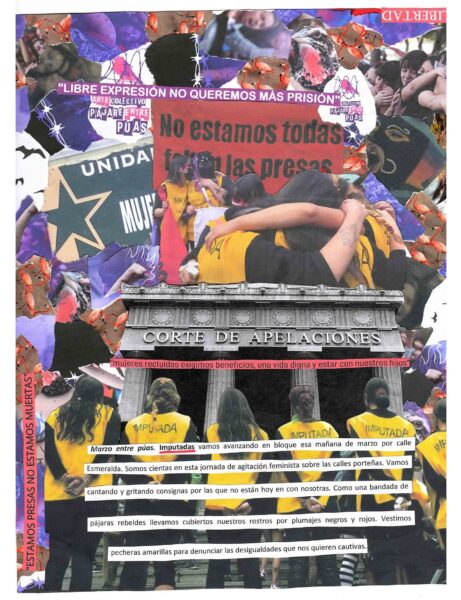
The breaking of the mother-child bond
“I am incarcerated, but, why does my tiny one have to be incarcerated? Then, I decided that my sister should take her and they went home”. (Paty, 54 años, Valparaíso)
The separation from their children — a product of imprisonment — constitutes an indelible milestone in the lives of these women: "When they take a child away from you, they come one day and tell you that today they are taking them away from you and the the National Service for Minors (SENAME) arrives (...) bye bye, you saw them for the last time and you went to the rooms” (Marjorie, 32 years old, Valparaíso).
However, the rupture of this bond does not only happen in one direction since the children — when they leave prison —- also experience a violent interruption of their psycho-emotional growth: "He is a baby who has no idea why, from one day to the next, he stopped seeing his mom” (Paty, 54 years old, Valparaíso).
This impact is mediated by the new socialization and care space in which the children will develop once they are forcibly separated from their mothers. The realities are diverse, while a large number of children remain in the custody of the National Service for Minors (SENAME), where most of the time their fundamental rights are violated, others remain in the care of other relatives, in their majority, of other women — indicating the feminine reproduction of care — like their aunts, grandmothers, neighbors and many times, their daughters, who take care of their younger siblings, which reproduces the cycle of violence, inequality and stigma that belongs to women: in this way, we can see how the prison enters the lives of many women when they are still minors.
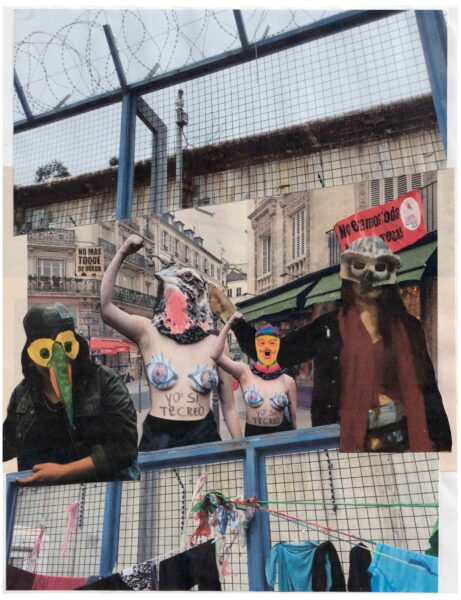
The rupture of the bond also affects — though differently — the children who are older than two. In this case, mothers and their children do not inhabit the prison space on a daily basis since they are immediately separated as a result of the imprisonment of their parents, their only way of having a relationship becomes the visits that take place within the detention facilities. Unfortunately, given the precarious conditions of the prison visitation system in Chile, family ties are deeply damaged within the process of being searched violently to enter the prisons in Chile:
“In the case of the searches carried out on children and adolescents, it was found that they are still carried out in an invasive way in various establishments. In more than half of the prisons inspected, it is reported by persons deprived of their liberty that they strip children or adolescents naked” (INDH,2019:306).
This has a relevant impact when, during the year of 2019, the visit of 30,921 children or adolescents to the different prisons throughout the country was reported (INDH, 2019). Regarding the space provided for visits, the same situation of violation of rights is repeated, in the particular case of the Valparaíso Women's Penitentiary Center, the visitation sector consists only of a patio without a roof or any protection, as indicated by the Institute of Human Rights: "In these places, there is no heating or a sufficient number of chairs and tables for people deprived of liberty and their visitors" (INDH, 2019:12).
In this way, mothers and children do not share an intimate space again until they obtain their freedom. This is something that can last for years when it is realized that — within this punitive system in which poverty is punished with imprisonment— the punishment is increasingly harsher, where, for non-violent crimes, such as those mentioned above, criminalized women can receive between one, three, ten or even more years of sentence, and therefore, without being and living with their children, meaning a profound rupture of affective bonds, since there is a loss of the accompaniment of the vital stages of development from early childhood onwards.
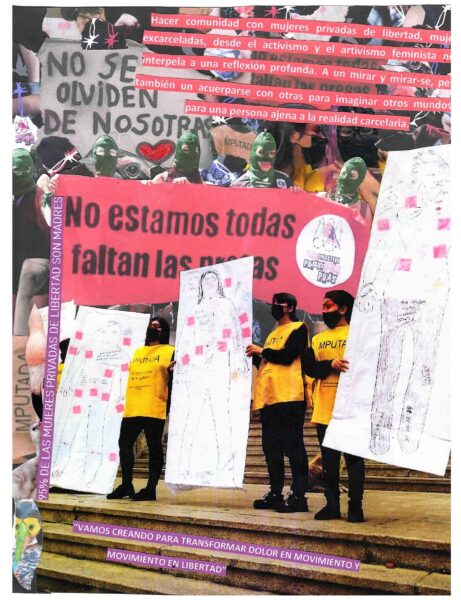
This is what Patricia reports:
“When I was imprisoned they were small children, and when I came out they all had problems, they had suffered mistreatment, they had suffered a lot of things. And I remember that in prison I thought of the children, because I knew they were not well, it was super sad (...) My son, who was the oldest, was 8 years old and when I got out he was a punk, that is, a super crazy process, they change and neither I nor the father was there, and then they blame you, and I have tried to explain to them that I did it thinking of them” (Paty, 54, Valparaíso).
In this way, the different obstacles can be observed, as well as the different subjectivities that are built from motherhood in prison, from each of the processes that incarcerated women who are part of the Pájarx Entre Púas community have experienced.
Reparative actions through the arts.
Community resistance
From our experience developing cultural and artistic actions, both in women's prisons and in cultural centers, together with communities and in public spaces, we have detected the systematic violence and structural inequalities that are perpetuated permanently in the lives of imprisoned women, formerly incarcerated women and their families, who directly experience the injustices of this capitalist, colonial and patriarchal system, which disconnects and dispossesses people of their communities, dismantling families, neighborhoods and organizations.
From that experience, we were able to identify how the lack of artistic spaces and cultural participation is strongly manifested within Chilean prisons and in neighborhood-territories, since in our country, arts and cultures have been conceived as private consumer goods for a privileged and elitist population, and not as a tool for development and social and territorial transformation.
This institutional conceptualization is verified through artistic-cultural segregation, as well as through an absence of programs and spaces that have a sense of territorial and community belonging in the different territories of Chile. It is this segregating structure of the arts that is exacerbated in the context of deprivation of liberty, adding to the stigma and countless difficulties that women face when they leave prison, and further hindering the possibilities of access and social and cultural participation.
Considering that only in the region of Valparaíso, 69% of the women who are deprived of their liberty have not finished the fourth grade and 21% have not completed their basic education, we can observe the critical situation and precarious access to the arts, cultures and education in the poorest sectors of the country. This is why developing pedagogical artistic tools in prisons is a way of empowering ourselves and vindicating ourselves as subjects of rights, recognizing our gender, class and ethnicity status (Hoecker, 2020).
Inhabiting the common territories and spaces that have been segregated for women and gender-sex dissidence is to constantly resist the capitalist system. This pushes us to collaboratively create a sisterly community through artistic and transformative tools to open new possibilities to build more empathetic communities that honor women for their knowledge and particularities.
Thus, we aim to deconstruct what is socially established, inviting us to feel, think and create from collective spaces to establish safe spaces of participation that find meaning for all and weave a network that strengthens the artistic and cultural social fabric of those of us considered crazy, deviant, misbehaved and dissident by patriarchal society.
With this in mind, the story of one of our fellow artivists, Paxi, makes sense; she is the daughter of a previously incarcerated woman. Both of them when retelling their own life stories, give an account of the process of repairing the mother-daughter bond through artistic, cultural and community tools:
“It is cool to develop the artistic area, the connection that can be made between pain, reality and mixing it with art and movement, perhaps someone may think that they are not related, but they are deeply related” (Paxi, 26, Valparaíso).
It is important to understand how, throughout history, we have been violated, explicitly and implicitly, violence that is registered on our corporalities, modifying the ways of relating to each other and denying us the right to make decisions about our bodies, violence that is reproduced behind the walls of prison, since the prison institution locks up and mistreats us, causing deep psychological, social, cultural wounds, etc.
These are wounds that go beyond these walls, also affecting families and mainly their children, since from a young age they are connected to prison, experiencing needs and inequalities that affect their development, which can be seen through psychological, sexual, economic, institutional violence, among many others, manifesting through their mental health, school dropout rates, few secure affective ties, in addition to no artistic and cultural participation, which consequently affects the entire family system:
"My mother would get out of prison and they didn't give her a job, it was a cycle of violence that never ended... She would get me and my brothers back, but she had to steal again from supermarkets, then she would fall prey again and we lost... That's how it was, until we were of legal age" (Paxi, 26, Valparaíso).
For us, well-being and protection means staying together in action and community through the arts, as it is a common and intersectional language capable of uniting the experiences of our various identities. As expressed by one of our colleagues from the sisterly community:
“The knowledge that the group has provided is positive for the life of my mother and all her formerly incarcerated friends. Getting to know each other, dancing, letting go, moving, perhaps they had never had that opportunity (...) People may believe that it is just moving, but it is not just moving, it goes further, something inside moves, it is something introspective and positive for everyone” (Paxi, 26, Valparaíso).
As Paxi emphasizes, it is not only the act of mobilizing the body, but also of removing stigmas and violences to break the bars of the multiple barriers imposed through the identities of woman, mother and prisoner.
Building the Nido Project
Following the necessity to strengthen the ties between mother and daughters, and break the prison bars during upbringing in a prison context through the arts, the Nido Project was born, which contemplates spaces for the development of significant experiences, using arts and culture as tools for bonding, containment and repair of affective and significant relationships in the development of childhoods, promoting secure attachment and a stable family bond, with the necessary equipment and care for a positive experience for both the mother as for their children.
In 2021, a research-action was carried out with a participatory methodology, where the main needs and suggestions arose from the life experiences of women-mothers who are in prison and also with the search for organizations and/or institutions with similar experiences across the world, where we only find experiences of this type in Europe and not in Latin America, once again demonstrating the significant shortcomings of the prison system in our region.
We contacted the various European organizations that have put this kind of work into practice, with more than 20 years of experience safeguarding safe spaces for the meeting and reunion of mothers with their daughters, which is why semi-structured interviews were conducted with organizations that work within a prison context in a permanent and comprehensive way for the link between mothers, fathers and their children through the arts, and being part of the "Children of Prisoners Europe" networks (Bambinisenzasbarre in Italy, Relais Enfants Parents in France, Belgium and Switzerland, and For Fangers Parorende in Norway), identifying their good practices and comprehensive, continuous and binding work management through the arts, among the caregivers in the context of imprisonment with their children.
Within this first stage of Project Nido, the workshop "Write, Tell and Fly!" in the Women's Penitentiary Center of Valparaíso, which aimed to create a safe and high quality space for the imprisoned women to create children's stories directed towards their children, through these stories they were able to express — using writing and narration — the various contexts and life stories that led them to be deprived of liberty and therefore separated from their children.
Thanks to this workshop, it was possible to address the affective, social and cultural dimensions that imply the rupture of the mother-child bond, in addition to building new negotiations and safer bonds during the exercise of motherhood while incarcerated. In this way we can account for how the arts enhance the emotions and subjectivities of those women who are structurally made invisible and violated by our punitive and patriarchal society.
Based on the experiences obtained in the research-action period, in2022 we began to carry out the "NIDO Significant Encounters" between incarcerated mothers and their children in the Cultural Park of Valparaíso — Ex Cárcel, a pioneering and unique action in Chile, organized by the Pájarx Entre Púas Collective and Foundation. This action included three national commemorative dates: Mother's Day, Girls' Day and Christmas. These dates carry important meanings and therefore constitute essential contact milestones for both mothers and their children, taking place in a memory-protected environment with a reparative and community approach.
The NIDO days were focused on cultural and community activities, which are specially prepared for meetings in support of strengthening ties, with the Collective being in charge of transferring women from the detention center (C.E.T: Center for Study and Work, La Pólvora, Valparaíso) as well as security, programming and care of each of the meetings.
It is important to mention the collaboration and active use of the space provided by the Cultural Park of Valparaíso - Ex Cárcel, cultural center of the region with which an alliance was developed that is reflected in the Vuelo de Pájares Program, which is committed to making connections between the cultural centers and women's prisons of the Valparaíso region as a main focus that the centers integrating this connection in their programming and editorial lines to enable the recognition of incarcerated persons as subjects worthy of cultural rights.
Simultaneously to the significant meetings, we have built a permanent workshop space with a reparative approach through personal and collective creation together with the women who participate in these meetings in the Cultural Park of Valparaíso Ex-Cárcel. This space aims to denormalize the gender violence associated with being a mother, to problematize the different experiences and constructions of motherhood and to support various parenting skills, revealing the work of each one based on their parenting experience with their children. Likewise, the permanence and continuity that is established with the incarcerated women who participate in this project is always based on developing secure affective bonds between all the participants — this is because we are part of this sisterly community.
Final reflections
Through these pages we sought to make visible the problem of prison and how it affects the lives of incarcerated women, particularly with regards to the constructions of motherhood and family ties with their children, girls and boys and adolescents who are socialized in the context of incarceration.
As a Collective and a Foundation, we appeal to a systematic understanding of prison so that society is aware of how it is formed as a space that builds violence and represses differences, a space of control and punishment that affects everyone, a structure of punishment that controls what is good and bad according to hegemonic and patriarchal canons that threaten life itself, that of women, dissidents, children, native peoples and migrants, and against all those marginalized by the neoliberal social contract. A space of seclusion that does us so much damage by fragmenting community ties that are the basis for the reproduction of a dignified life, of life in families, neighborhoods and territories.
Although this article is based on reports of unique memories from Valparaíso, Chile, together with a group of previously incarcerated women who belong to our community, we know that these experiences echo in the lives of thousands of women, pregnant people and children from all over the Latin American continent, who have gone through prison, and with greater emphasis for those who today are still imprisoned behind the bars of punishment.
With this article, we make a Latin American activist and transfeminist call for us to build together other alternatives to mass incarceration that we are currently witnessing. Alternatives that are sustained from the community, making use of arts and culture as tools that enable other possible worlds, since, as Angela Davis said in her work “Are prisons obsolete?:
“An abolitionist approach that seeks to answer questions like these would require us to imagine a constellation of alternative strategies and institutions, with the ultimate goal of removing prison from the social and ideological landscapes of our society. In other words, we would not be looking for jail-type substitutes for prison, such as house arrest secured by electronic surveillance bracelets. Instead, positing decarceration as our overarching strategy, we will try to envision a continuum of alternatives to incarceration: demilitarization of schools, revitalization of education at all levels, a health system that provides free physical and mental care for all , and a justice system based on reparation and reconciliation rather than retribution and revenge”. (2003:126)
In the following sections, we present a sample of the work done by our incarcerated comrade during the event “Write, Tell and Fly!” at Valparaíso
.(Proyecto Nido – Fundación y Colectiva Pájarx entre Púas – 2021)
Taught by the actress, narrator and director Gabriela Fernández Chang, MG in Education and scenic artist Myr Chávez and the Psychologist Vania Gallardo.
THE STAR AND THE GOATS
By Vanessa
A long time ago in a place not so far away, a beautiful girl was born, she was a baby girl with caramel-colored eyes, she had a restless look, as if she wanted to know everything at once, her mother called her Estrella, precisely because of those eyes that emitted a bright light. The mother was dedicated to selling little goats, in that place and back then, the little goats were not very well seen, because when someone tried them, later they could not stop eating them, they could not help wanting more, when they did not have them, they were capable of doing anything for them and transforming people into unspeakable creatures.
When Estrella turned 10 years old, she experienced her first love, a love so strong, just like first loves are, that blinds you and makes you see everything as beautiful, beautiful and perfect, what Estrella did not know is that that boy was crazy for the little goats, at first he was affectionate, but later he became a monster that trapped her, he forced her to eat little goats, he sent her to the street to look for money to buy more, more and more little goats. Woe to Estrella if she didn't come with the money! The monster did the things that monsters do, monstrous things, Estrella's light went out, she no longer recognized herself, she couldn't live without those little goats.
When she turned 16, a boy arrived, who fought for her, freed her from the monster, he was her new love, he planted a little seed and a life began to grow, they had a beautiful son, today he is a man that Estrella is proud of, he had to learn to get ahead on his own, because the power of the little goats was so great that Estrella could not get rid of them so easily.
One night, she was eating the goats and they ran out. She wanted to buy more, but she had no money so she went out to get some. It seemed that Estrella was immersed in darkness, she had no will of her own, she was driven by the power of the goats that took her to the front of a house, the ideal house where she could find what she needed so much.
The house was like a safe, Estrella did not see that, she was possessed, she managed to get in by squeezing between the bars, she was thin as a board and she passed through the middle, she was very surprised when the owners of the place found her, they did not know Estrella’s story, they did not know that she was as scared as they were, they took her, they severely mistreated her, they called the security forces and with excessive force, they locked her behind bars and despite being thin as a board she could not escape. Estrella is still there, along with other women condemned by the system, the little goats became history, an almost terrifying tale, but the beautiful thing is that their light gradually turns on again, sometimes it shines brightly, sometimes it goes out a little. little, but she shines every day, thinks of her son, thinks of her new life as when she came into this world, with those caramel-colored eyes, hoping to be able to know everything and shine, shine, shine.
THE GARDEN OF WONDERS
By Jocelyn
Once upon a time, in a very large and beautiful garden, there was a wonderful flower called Maravilla, who lived happily, surrounded by much love. Since Maravilla was little, the gardeners gave her a lot of love and care.
Maravilla grew and grew, until she became a beautiful adolescent flower, one day a young Sunflower appeared in the garden, who fell in love with Maravilla, and as in stories, sometimes things happen very quickly, Maravilla and Sunflower had two beautiful tulips .
The family lived in the same garden for many years, Maravilla was a little girl when she got together with Girasol and over time she began to know the true personality of her partner.
Girasol was very sweet when he wanted to be, but if something bothered him, spikes appeared from inside him, he turned into a cactus and hurt everyone around him, especially Maravilla.
Sometimes there were days when the sun came out and Maravilla felt good, other times there were rainy days when she turned into a cactus, those days she didn't remember very well.
One rainy day, everything ended and Maravilla was herself again, she cut Girasol out of her life. But as time passed, an ogre appeared in the garden and poisoned it with pesticides, Maravilla began to wither little by little, she began to lose track of what was happening and did not realize what was happening to her or to the garden.
She couldn’t see the garden like before and one of those days Girasol appeared again with his cactus soul, which annoyed Maravilla a lot, and they started arguing, at that moment a cat appeared with griffons and Maravilla pounced on the cat and attacked him.
The caretaker of the garden took Maravilla and took her to a greenhouse, she felt very alone and enclosed, everything around her was unknown, she felt so far away from her beautiful garden.
With the passage of time, Maravilla returned home, but unfortunately she met the ogre who sprayed her with pesticide and so she could not comply with the rules that had been given to her to maintain her freedom and they took her to the greenhouse, but not to the same one, to another one, one in the big city, five years and one day, she had to be in that terrible place.
Maravilla has been in that huge greenhouse for 22 months, far from her beloved tulips, and she struggles every day in the hope of reuniting with her beloved children.
Works:
María Paz Córdova Lagos,
Visual feminist art – Creation and
Sustainability team of the Pájarx entre Púas
Foundation and Collective..
Marión Silva,
Visual Artist – Collaborator of the Pájarx entre Púas
Foundation and Collective.
Sent: July 26th, 2022.
Agencia Uno (2021). Fiscalía abre investigación por presunto maltrato en centro del Sename. El Desconcierto Chile. Disponible en: https://www.eldesconcierto.cl/nacional/2021/04/27/fiscalia-abre-investigacion-por presunto-maltrato-en-centro-del-sename.html
Albert, C y Urquieta Ch, C (2019). Menores del Sename denuncian abuso policial: lesiones oculares, tocaciones, amenazas de fusilamiento y golpizas. Revista Ciper Chile. Disponible en: https://www.ciperchile.cl/2019/11/15/menores-del-sename-denuncian-abuso-policial lesiones-oculares-tocaciones-amenazas-de-fusilamiento-y-golpizas/
Castro, S y Gallardo V. (2020) Investigación, Resistencias: Mujeres que han sido privadas de su libertad. Chile. Disponible en: https://pajarxentrepuas.cl/investigacionaccion/investigaciones/
Cortazar, A., Férnandez, P., Léniz, I., Quesille, A., Villalobos. C, y Vielma, C. (2015). ¿Qué pasa con los hijos de madres encarceladas? Cómo amortiguar los efectos nocivos para los niños cuyos padres están privados de libertad. Instituto de Políticas Públicas: UDP.
Davis, A. (2003). ¿Son obsoletas las prisiones? Bocavulvaria Ediciones Córdoba, Argentina.
Gendarmería de Chile (GENCHI). (2019). Boletín Estadístico: Población femenina privada de libertad. Santiago de Chile.
Gendarmería de Chile (GENCHI) (2012). Manual de Derechos Humanos de la Función Penitenciaria. Disponible en: https://html.gendarmeria.gob.cl/doc/ddhh/Archivos_Adicionales/MANUAL_DDHH_GENCHI_FINAL.pdf
Hoecker, K. (2020). Diagnóstico territorial sobre las artes, culturas y educación en contexto privado de libertad en la Región de Valparaíso, Chile. Fundación y Colectiva Pájarx entre Púas. Disponible en: https://pajarxentrepuas.cl/investigacionaccion/investigaciones/
Larroulet, P., Droppelmann, C., Daza, S., Del Villar, P., & Figueroa, A. Reinserción, Desistimiento y Reincidencia en Mujeres.
Instituto Nacional de Derechos Humanos (INDH) (2021). ESTUDIO DE LAS CONDICIONES CARCELARIAS EN CHILE 2019. Diagnóstico del cumplimiento de los estándares internacionales de derechos humanos en la privación de libertad. Disponible en: https://bibliotecadigital.indh.cl/handle/123456789/1727#:~:text=Resumen%3A,de%20las%20c%C3%A1rceles%20del%20pa%C3%ADs.
Palma, S (2021). El último grito de ayuda de una niña del Sename. The Clinic Chile. Disponible en: https://www.theclinic.cl/2021/08/16/el-ultimo-grito-de-ayuda-de-una-nina del-sename/
Restrepo, D. y Francés, P. (2016). Rasgos comunes entre el poder punitivo y el poder patriarcal. Rev. colomb. soc., 39(1), pp. 21-46.
Walmsley, R. (2018). World female imprisonment list. World Prison Brie
Vania Gallardo López | CHILE |
Feminist Psychologist and Coordinator of the psychosocial area of the Foundation and Collective Pájarx entre Púas
Eva Lineros Vega | CHILE |
Degree in Social Anthropology - Research-action Team Foundation and Collective Pájarx entre Púas.
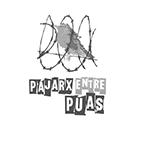
Pajarx Entre Puas | CHILE |
Foundation and Collective Transdisciplinary - Feminist working from Pedagogy, Body, Art and Memory. Our main objective is to build a sorority community of women and dissidents, incarcerated, released and feminist artists, which allows to devise networks of containment and creation to subvert and imagine together a world without prisons.

